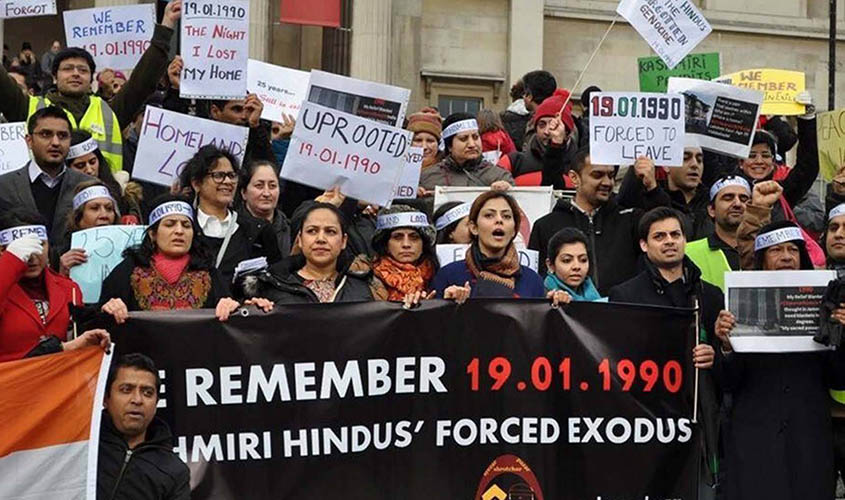19 January 1990 is an infamous day in the history of Kashmir. It was the day that the Kashmiri Hindu community was hounded out their homeland to the chant of blood curdling slogans. It is imperative that we recall the events of those fateful days of 1990.
The targeting of Hindus began in late 1989. The first to be killed was Pandit Tika Lal Taploo, a prominent leader of the Kashmiri Hindu Pandit community: he was gunned down in broad daylight outside his home in front of several eyewitnesses by terrorists but no one was ever charged.
Four months later, on 4 January 1990, Aftab, a local Urdu newspaper in Srinagar, runs a press release issued by the Pakistan based terrorist outfit Hizbul Mujahideen, proclaiming jihad and asking all Hindus to leave the valley. Walls are plastered with posters asking Hindus to leave Kashmir, homes of Hindus are dotted red to identify them and Hindu women are forced to sport marks on their foreheads (tilak); masked men with Kalashnikovs roam the streets, forcing people to reset their watches and clocks to Pakistan Standard Time. The scene was reminiscent of Nazi Germany, only the yellow arm bands damning the Jews were missing.
A reign of terror rules the Valley, unchecked by the local government. The predominantly Muslim Kashmiri society, 7 million strong, feigns helplessness against a few hundred terrorists and forsakes the minority Hindu community to its fate.
With each passing day of January, the tension mounts. Then on 19 January 1990, dubbed as the Kristallnacht of the Kashmiri Hindu Pandit community, the pressure reaches its zenith. As dusk approaches and Hindu families, women and children included, cower inside their homes, behind the false security of their doors, outside the spine-chilling exhortations to leave the Valley become louder and shriller. The muezzin’s routine calls to the Islamic faithful from mosque tops is replaced by three taped slogans that resonate throughout the cold January night, its eerie darkness accentuating the fear instilled by these repeated incantations:
“Kashmir mei agar rehna hai, Allah-O-Akbar kehna hai (If you want to stay in Kashmir, you have to say Allah-O-Akbar)”.
“Yahan kya chalega, Nizam-e-Mustafa (What do we want here? Rule of Shariat)”.
“Asi gachchi Pakistan, Batao roas te Batanev san (We want Pakistan along with Hindu women but without their men)”.
The depravity of the slogans is beyond human comprehension. Grabbing just what they can carry, Kashmiri Pandits flee the valley, leaving behind their ancestral homes—thus began the most recent exodus of Kashmiri Pandits (history is witness to several forced migrations of Kashmiri Pandits during the last millennium).
Over the ensuing months, abandoned Hindu homes are deliberately gutted and those that could not be burnt because of their proximity to Muslim homes are skilfully damaged so that they would cave in under the harsh winter weather, making pilfering of material easy; some Pandits who chose to stay back are subtly intimidated by their Muslim “friends” to sell their properties at throwaway prices. Approximately, 16,000 Hindu homes suffer this fate.
According to IDMC (internal displacement monitoring centre of the Norwegian Refugee Council) 350,621 Kashmiri Pandits have been displaced from the valley since the insurgency began. Anywhere between 500 to 1,000 Hindus were killed during this period. Group massacres were common: Wandhama, Chapnari, Prankote and Nandimarg are few of the locales that come to mind where groups of Hindus were mercilessly gunned down by terrorists with the local population complicit in these killings.
At the beginning of the 20th century there were close to 1 million Kashmiri Pandits. Today not more than 9,000 Pandits remain; some put the figure even lower at 3,000. Kashmiri Hindus made up 15% of the population in 1941. By 1991, their numbers had dwindled to comprise a mere 0.1%. These are the stark facts that tell the tale of the Kashmiri Hindu. When the population of a specific community is decimated by fear from over 1 million to less than 10,000 and now constitutes a bare 0.1% of the population, there is only one word to describe it: ethnic cleansing.
Although the abrogation of Article 370 has changed the ground reality in Kashmir it cannot negate the ethnic cleansing of Kashmiri Pandits: a humungous moral infraction that stands as an indelible blot on the moral fabric of India; a shame for a people.
While it is easy to blame the terrorists, it cannot absolve us of our responsibility. There was a total failure, at every level of the defence mechanisms that define a civilised nation: society, government and the press—all abrogated their responsibility and failed the Kashmiri Hindu.
What happened in Kashmir could not have occurred without the tacit compliance of civil society, Kashmir’s majority Muslim community and so, despite their protestations, they must bear the brunt of this charge.
More disturbing is the mute acceptance of this barbaric monstrosity by civil society and the media. When we can crowd the streets for a surreal crime, a supposed act of potential discrimination that is more paranoia than fact or logic like the Citizenship Amendment Act (CAA), why were there were no street protests, no candle light vigils, no media brouhaha and no sit ins like Shaheen Bagh for this brutal act of ethnic cleansing?
That is the million-dollar question. Was it because the victims were Hindus? Indian civil society must introspect and have the courage to confront this demon that hovers over us.
No nation can lay claim to democracy and secularism if it has different benchmarks of victimhood depending on the community. Some crimes cannot be more equal than others. And the purpose of recalling history is not to wreak vengeance, but to evoke remorse among the perpetrators and to ensure that such evil does not happen again—nothing more nothing less.

